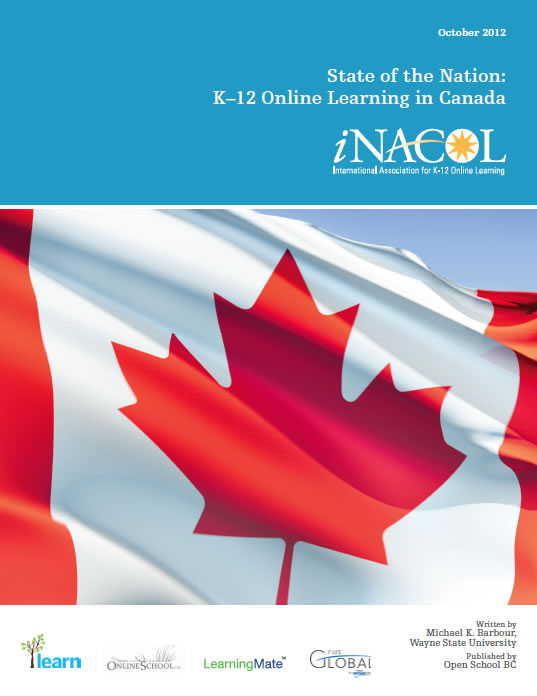While those attending the Computer Users in Education-British Columbia conference this past week received advanced notice, the 2012 State of the Nation: K-12 Online Learning in Canada report was officially released today at the International Association for K-12 Online Learning‘s Virtual School Symposium in New Orleans.

This year’s report was sponsored by Learn, Heritage Christian Online Schools, LearningMate Solutions, and Florida Virtual School Global. It was published by Open School British Columbia. The executive summary of the report reads:
This is the fifth edition of the State of the Nation: K–12 Online Learning in Canada report. The purpose of this annual investigation is to describe the policies and regulations that govern K–12 distance education in each of the thirteen Canadian provinces and territories. The study is also designed to survey the level of K–12 distance education activity across the country.
Over the past year there have been few changes to the regulation of K–12 distance education in Canada. Some provinces and territories still have little to no regulation. There are other provinces and territories that have passing references to distance education in their Education Act or Schools Act—often language that is no longer relevant due to changes with distance education delivery or the nature of K–12 distance education programs in operation. Further, there are several provinces and territories that use policy documents issued by the Ministry of Education. Finally, there is one province that has articles included in the collective bargaining agreement between the Government and teachers’ union, with one province that has an extensive legislative regime. British Columbia continues to have the most structured regulatory regime, while Quebec and Saskatchewan continue to have no regulation at all for K–12 distance education. Finally, there are several provinces that are in the process of reviewing their distance education policies (e.g., New Brunswick, Manitoba and Alberta).
The level of K–12 distance education activity in Canada continues to grow, although that growth is uneven and only experienced in certain jurisdictions. There also continues to be some level of K–12 distance education activity in all thirteen provinces and territories, with British Columbia having the highest number and highest percentage of student participation and Nunavut having the lowest. Further, the total number and proportion of K–12 students enrolled in distance education has increased from 2010–11 to 2011–12. However, that growth was isolated to a few jurisdictions—namely British Columbia, Quebec, Ontario, and Alberta. Provinces that have had longstanding distance education programs, particularly those in Eastern Canada, have seen more consistent levels of K–12 distance education participation. Finally, there also continues to be a reliance on print-based methods of distance education delivery in some jurisdictions.
The full report can be accessed at:
http://www.openschool.bc.ca/pdfs/iNACOL_CanadaStudy_2012.pdf
Earlier this morning, a panel consisting of Sarah Hainsworth (Coordinator for Distributed Learning in the Nova Scotia Department of Education), Michael Canuel (Chief Executive Officer of LEARN), Karen Flello (Vice Principal for the South Island Distance Education School), and Carey Eldridge (District E-Learning Contact for the Lambton-Kent District School Board) described their own experiences within the K-12 online learning environment. Those attending the conference can access session materials at http://vss2012.inacol.pathable.com/#meetings/90158 (however, unlike previous year’s those of us not registered for the conference are unable to access these materials).
